Emergency Department Visits for Asthma
Emergency department visits for asthma per 100,000 population, ages 18-39, by sex, 2008-2011
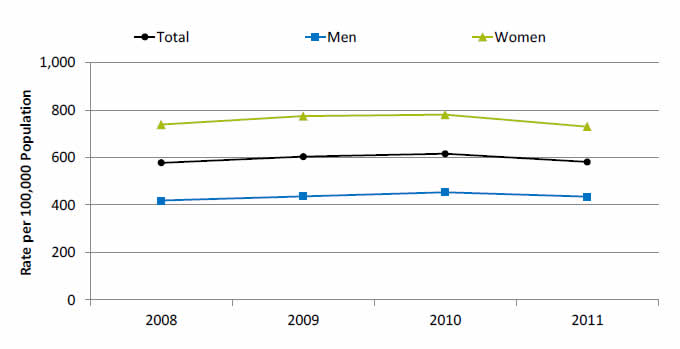
| Year | Total | Men | Women |
|---|---|---|---|
| 2008 | 578 | 419.1 | 739.3 |
| 2009 | 604.2 | 436.4 | 774.6 |
| 2010 | 616.3 | 453.9 | 781.2 |
| 2011 | 582 | 435.6 | 730.6 |
Source: Agency for Healthcare Research, Healthcare Cost and Utilization Project, Nationwide Emergency Department Sample, 2008-2011.
- Importance:
- Regardless of age, race, ethnicity, sex, class, income, or personal history, advances in asthma treatment mean that asthma control is achievable for nearly all persons with asthma, but only if clinicians and patients join together to follow the asthma guidelines (NHLBI).
- People with asthma need proper medical care to manage their disease. When their asthma is controlled with routine care and education, they are less likely to visit emergency departments and urgent care facilities for asthma-related treatments (CDC).
- In 2013, asthma prevalence was 6.2% among males and 8.3% among females (CDC).
- Trends:
- From 2008 to 2011, the overall rate of emergency department visits for asthma increased from 578 to 582 per 100,000 population.
- Rates of emergency department visits for asthma among women decreased from 739.3 to 730.6 and among men increased from 419.1 to 435.6 per 100,000 population.
- None of these changes were statistically significant.
- Groups With Disparities:
- In all years, women were much more likely (more than 1.5 times) to have an emergency department visit for asthma than men.
- The gap between men and women grew smaller, indicating improvement.
Potentially Avoidable Hospitalizations for All Conditions
Potentially avoidable hospitalizations for all conditions per 100,000 population, age 18 and over, by sex, 2005-2012, and by race/ethnicity, 2012
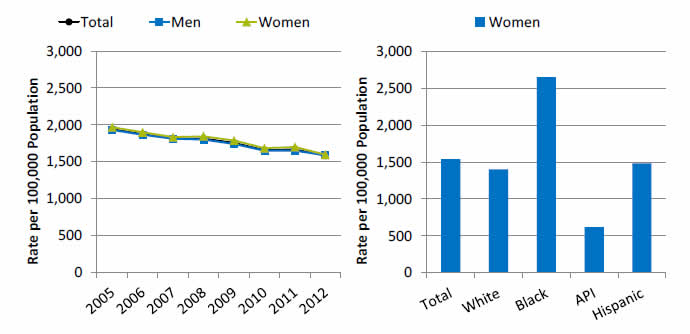
Left Graph (Sex):
| Year | Total | Men | Women |
|---|---|---|---|
| 2005 | 1941.23 | 1929.01 | 1969.24 |
| 2006 | 1873.5 | 1864.25 | 1898.64 |
| 2007 | 1814.25 | 1810.49 | 1833.97 |
| 2008 | 1814.54 | 1797.56 | 1845.96 |
| 2009 | 1756.53 | 1738.55 | 1787.62 |
| 2010 | 1658.32 | 1646.97 | 1683.02 |
| 2011 | 1669.29 | 1649.46 | 1701.29 |
| 2012 | 1582.43 | 1584.32 | 1596.32 |
Right Chart (Women, by Race/Ethnicity):
- Total - 1537.5.
- White - 1401.8.
- Black - 2653.9.
- API - 615.9.
- Hispanic - 1482.9.
Key: API = Asian or Pacific Islander.
Source: Agency for Healthcare Research and Quality (AHRQ), Healthcare Cost and Utilization Project, 2005-2011 Nationwide Inpatient Sample, 2012 State Inpatient Databases disparities analysis file, and AHRQ Quality Indicators, version 4.4.
Note: White, Black, and API are non-Hispanic. Hispanic includes all races. All conditions based on the 12 AHRQ Prevention Quality Indicators for angina, asthma, bacterial pneumonia, chronic obstructive pulmonary disease, congestive heart failure, dehydration, diabetes, hypertension, and urinary tract infection.
- Importance: Hospitalization is expensive. Preventing avoidable hospitalizations could reduce health care costs. Not all hospitalizations that the AHRQ Prevention Quality Indicators (PQIs) track are preventable. But ambulatory care-sensitive conditions are those for which good outpatient care can prevent the need for hospitalization or for which early intervention can prevent complications or more severe disease. The AHRQ PQIs track these conditions using hospital discharge data.
- Trends: From 2005 to 2012, overall rates for potentially avoidable hospitalizations for all conditions improved from 1,941 to 1,582 per 100,000 population. Rates improved among men and women.
- Groups With Disparities:
- In all years, there were no statistically significant differences between men and women.
- In 2012, Asian and Pacific Islander (API) women were less likely than White women to have potentially avoidable hospitalizations (615.9 compared with 1,401.8 per 1000,000 population). Black women were more likely than White women to have potentially avoidable hospitalizations (2,653.9 compared with 1,401.8 per 1000,000 population).
Potentially Avoidable Hospitalizations for Chronic Conditions
Potentially avoidable hospitalizations for chronic conditions per 100,000 population, age 18 and over, by sex, 2005-2012, and by race/ethnicity, 2012
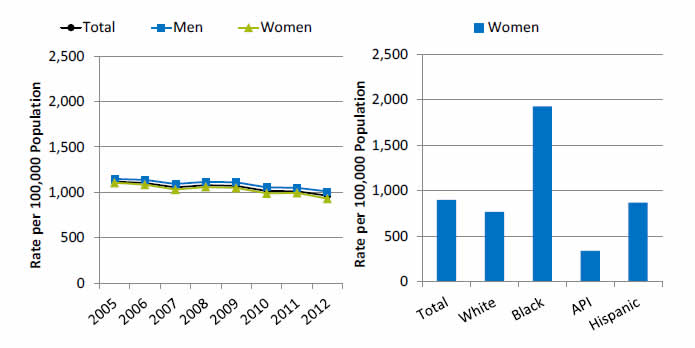
Left Graph (Sex):
| Year | Total | Men | Women |
|---|---|---|---|
| 2005 | 1118.41 | 1145.89 | 1103.15 |
| 2006 | 1102.51 | 1135.77 | 1083.04 |
| 2007 | 1053.36 | 1090.15 | 1030.14 |
| 2008 | 1078.22 | 1114.3 | 1057.76 |
| 2009 | 1070.71 | 1108.93 | 1047.8 |
| 2010 | 1012.91 | 1054 | 986.96 |
| 2011 | 1012.3 | 1047.37 | 991.62 |
| 2012 | 960.95 | 1009.32 | 929.15 |
Right Chart (Women, by Race/Ethnicity):
- Total - 898.1.
- White - 766.3.
- Black - 1926.9.
- API - 338.9.
- Hispanic - 868.6.
Key: API = Asian or Pacific Islander.
Source: Agency for Healthcare Research and Quality (AHRQ), Healthcare Cost and Utilization Project, 2005-2011 Nationwide Inpatient Sample, 2012 State Inpatient Databases disparities analysis files, and AHRQ Quality Indicators, version 4.4.
Note: White, Black, and API are non-Hispanic. Hispanic includes all races.
- Importance: Hospitalization is expensive. Preventing avoidable hospitalizations could reduce health care cost. Not all hospitalizations that the AHRQ PQIs track are preventable. But ambulatory care-sensitive conditions are those for which good outpatient care can prevent the need for hospitalization or for which early intervention can prevent complications or more severe disease. The AHRQ PQIs track these conditions using hospital discharge data. Hospitalizations for chronic conditions include diabetes and congestive heart failure.
- Trends: From 2005 to 2012, overall rates of potentially avoidable hospitalizations for chronic conditions improved from 1,118 to 961 per 100,000 population. The rates improved among both men and women.
- Groups With Disparities:
- In all years, there were no statistically significant differences between men and women in the rate of potentially avoidable hospitalization for chronic conditions.
- In 2012, API women were less likely than White women to have potentially avoidable hospitalizations for chronic conditions (338.9 compared with 766.3 per 100,000 population). Black women were more likely than White women to have potentially avoidable hospitalization for chronic conditions (1,926.9 compared with 766.3 per 100,000 population).
Admissions With Hypertension
Admissions with hypertension per 100,000 population, by sex, 2007-2012, and by race/ethnicity, 2012
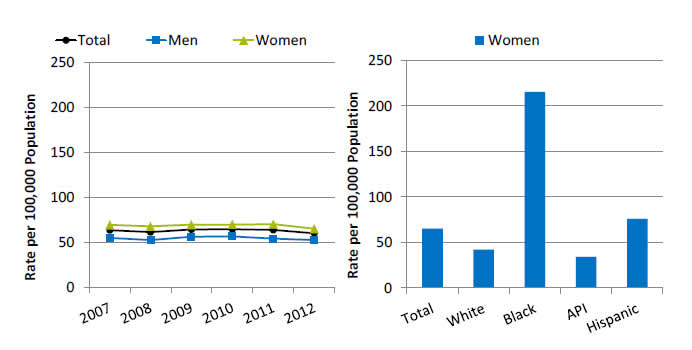
Left Graph (Sex):
| Year | Total | Men | Women |
|---|---|---|---|
| 2007 | 63.4 | 54.9 | 69.4 |
| 2008 | 61.2 | 52.3 | 67.7 |
| 2009 | 64.1 | 56.1 | 69.6 |
| 2010 | 64.4 | 56.5 | 69.7 |
| 2011 | 63.6 | 54.1 | 70.1 |
| 2012 | 60.1 | 52.5 | 65.0 |
Right Chart (Women, by Race/Ethnicity):
- Total - 65.1.
- White - 41.8.
- Black - 215.6.
- API - 34.
- Hispanic - 75.9.
Source: Agency for Healthcare Research and Quality (AHRQ), Healthcare Cost and Utilization Project, 2007-2011 Nationwide Inpatient Sample, 2012 State Inpatient Databases disparities analysis files, and AHRQ Quality Indicators, version 4.4.
Note: White, Black, and API are non-Hispanic. Hispanic includes all races.
- Importance: About 70 million American adults (29%) have high blood pressure (Nwankwo, et al., 2013). High blood pressure costs the Nation $46 billion each year. This total includes the cost of health care services, medications to treat high blood pressure, and missed days of work. For people age 65 and over, high blood pressure affects more women than men (Mozzafarian, et al., 2015).
- Trends:
- From 2007 to 2012, the overall rate of admissions with hypertension improved from 63.4 to 60.1 per 100,000 population.
- During this time, the rate worsened among men, but there were no statistically significant changes among women.
- Groups With Disparities:
- In 2012, overall, women had higher rates of admissions with hypertension than men.
- In 2012, the rate of admissions with hypertension for Black women was more than five times the rate for White women.
Admissions With Chronic Obstructive Pulmonary Disease or Asthma
Admissions with chronic obstructive pulmonary disease or asthma per 100,000 population, age 40 and over, by sex, 2005-2012, and by race/ethnicity, 2012
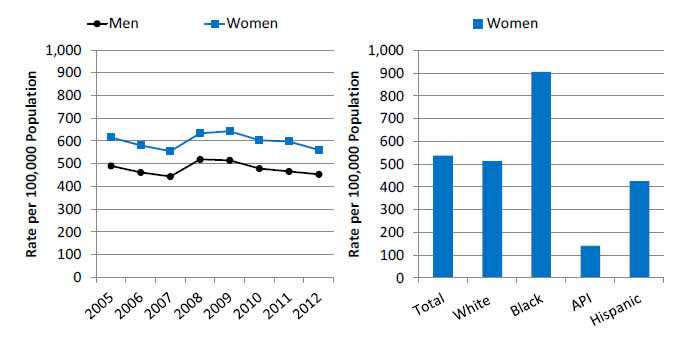
Left Graph (Sex):
| Year | Men | Women |
|---|---|---|
| 2005 | 490.27 | 616.09 |
| 2006 | 461.19 | 580.04 |
| 2007 | 443.83 | 554.97 |
| 2008 | 519.02 | 633.09 |
| 2009 | 514.84 | 643.24 |
| 2010 | 478.32 | 602.99 |
| 2011 | 466.03 | 597.83 |
| 2012 | 452.95 | 560.48 |
Right Chart (Women, by Race/Ethnicity):
- Total - 537.6.
- White - 512.8.
- Black - 906.
- API - 139.9.
- Hispanic - 424.9.
Source: Agency for Healthcare Research and Quality (AHRQ), Healthcare Cost and Utilization Project, 2005-2011 Nationwide Inpatient Sample, 2012 State Inpatient Databases disparities analysis files, and AHRQ Quality Indicators, version 4.4.
Note: White, Black, and API are non-Hispanic. Hispanic includes all races.
- Importance: According to the American Lung Association (2013), more than 7 million women in the United States live with chronic obstructive pulmonary disease (COPD). Millions more have the disease but are undiagnosed, possibly due to the common misdiagnosis of asthma for female COPD patients. In fact, the number of deaths among women from COPD has increased fourfold over the past three decades and, since 2000, more women than men in this country have died of the disease.
- Trends: From 2005 to 2012, there were no statistically significant changes overall among women or men in the rate of admissions with COPD.
- Groups With Disparities:
- In all years, women had higher rates of admissions with COPD than men.
- In 2012, rates of admission with COPD per 100,000 population were significantly lower for API (139.9) and Hispanic women (424.9) than White women (512.8).
- The rate of admissions with COPD for Black females was nearly twice the rate of White females.
Emergency Department Visits Related to Mental Health, Alcohol, or Substance Abuse
Emergency department visits with a principal diagnosis related to mental health, alcohol, or substance abuse per 100,000 population, by sex, 2007-2011
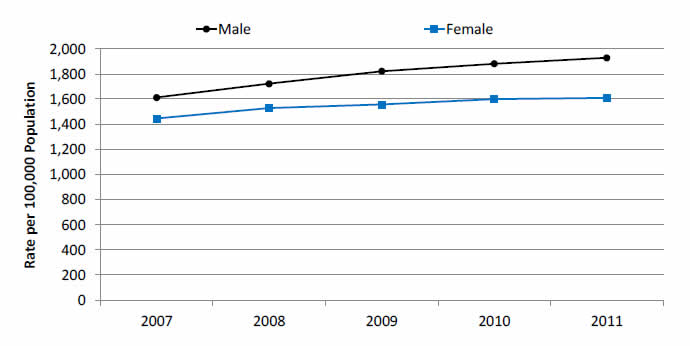
| Year | Male | Female |
|---|---|---|
| 2007 | 1613.4 | 1444.8 |
| 2008 | 1722.4 | 1528.5 |
| 2009 | 1821.9 | 1556.7 |
| 2010 | 1881.9 | 1599.4 |
| 2011 | 1928.6 | 1609.1 |
Source: Agency for Healthcare Research and Quality, Healthcare Cost and Utilization Project, Nationwide Emergency Department Sample, 2007-2011.
- Importance: An estimated one in three individuals has suffered from a mental health or substance abuse condition within the last 12 months, yet the community treatment system to support services for these individuals is regarded by the Institute of Medicine as ineffective (Owens, et al., 2010). In 2011, about 609,000 of the 1.84 million admissions (33.1%) to substance abuse treatment were female, and 1.23 million were male (66.9%). However, specific types of mental disorders vary by sex. For instance, women are more likely than men to experience an anxiety or mood disorder, such as depression, while men are more likely to experience an impulse control or substance use disorder (HRSA, 2013).
- Trends: From 2007 to 2011, the rates of emergency department visits with a principal diagnosis related to mental health, alcohol, or substance abuse worsened overall and for both males and females.
- Groups With Disparities: In all years, females were less likely to have an emergency department visit with a principal diagnosis related to mental health, alcohol, or substance abuse compared with males.



